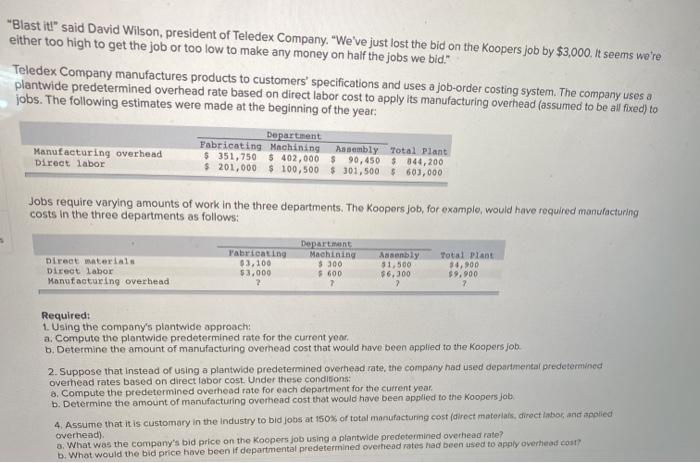"Blast it!" said David Wilson, president of Teledex Company. "We've just lost the bid on the Koopers job by $3,000. It seems we're either too high to get the job or too low to make any money on half the jobs we bid." Teledex Company manufactures products to customers' specifications and uses a job-order costing system. The company uses a plantwide predetermined overhead rate based on direct labor cost to apply its manufacturing overhead (assumed to be al fixed) to jobs. The following estimates were made at the beginning of the year: Department Fabricating Machining Assembly Total Plant Manufacturing overhead $ 351,750 5 402,000 $ 90,450 $ 044,200 Direct labor $ 201,000 $ 100,500 $ 301,500 $ 60,000 Jobs require varying amounts of work in the three departments. The Koopers job, for example, would have required manufacturing costs in the three departments as follows: Direct materiale Direct labor Manufacturing overhead Fabricating 03.100 $3,900 2 Department Machining 3.300 5 600 2 Asanbly 31,500 $6.300 2 Total Plant 34,900 $9.900 2 Required: 1. Using the company's plantwide approach: a, Compute the plantwide predetermined rate for the current year, b. Determine the amount of manufacturing overhead cost that would have been applied to the Koopers job 2. Suppose that instead of using a plantwide predetermined overhead rate, the company had used departmental predetermined overhead rates based on direct labor cost. Under these conditions: 8. Compute the predetermined overhead rate for each department for the current year, b. Determine the amount of manufacturing overhead cost that would have been applied to the Koopers job 4. Assume that it is customary in the industry to bid jobs at 150% of total manufacturing cost (direct materials, direct inbor and apoled overhead) a. What was the company's bid price on the Koopers job using a plantwide predetermined overhead rate? b. What would the bid price have been if departmental predetermined overhead rates had been used to apply overhead coat Required 1A Required 1B Required 2A Required 2B Required 4A Required 4B Using the company's plantwide approach, compute the plantwide predetermined rate for the current year. Predetermined overhead rate % of direct labor cost ROOM SA Required 16 > Required 1A Required 1B Required 2A Required 2B Required 4A Required 48 Using the company's plantwide approach, determine the amount of manufacturing overhead cost that would have been applied to the Koopers job. Manufacturing overhead cost applied Suppose that instead of using a plantwide predetermined overhead rate, the company had used departmental predetermined overhead rates based on direct labor cost. Compute the predetermined overhead rate for each department for the current year: Predetermined Overhead Rate Fabricating department Machining department % of direct labor cost Assembly department of direct labor cost % of direct labor cost % Required 1A Required 1B Required 2A Required 28 Required 4A Required 48 Suppose that instead of using a plantwide predetermined overhead rate, the company had used departmental predetermined overhead rates based on direct labor cost. Determine the amount of manufacturing overhead cost that would have been applied to the Koopers job. Manufacturing overneed cost applied Required 1A Required 1B Required 2A Required 2B Required 4A Required 4B Assume that it is customary in the industry to bid jobs at 150% of total manufacturing cost (direct materials, direct labor, and applied overhead). What was the company's bid price on the Koopers Job using a plantwide predetermined overhead rate? Company's bid price Required 1A Required 1B Required 2A Required 28 Required 4A Required 4B Assume that it is customary in the industry to bid jobs at 150% of total manufacturing cost (direct materials, direct labor, and applied overhead). What would the bid price have been If departmental predetermined overhead rates had been used to apply overhead cost? Manufacturing overhead cost applied













